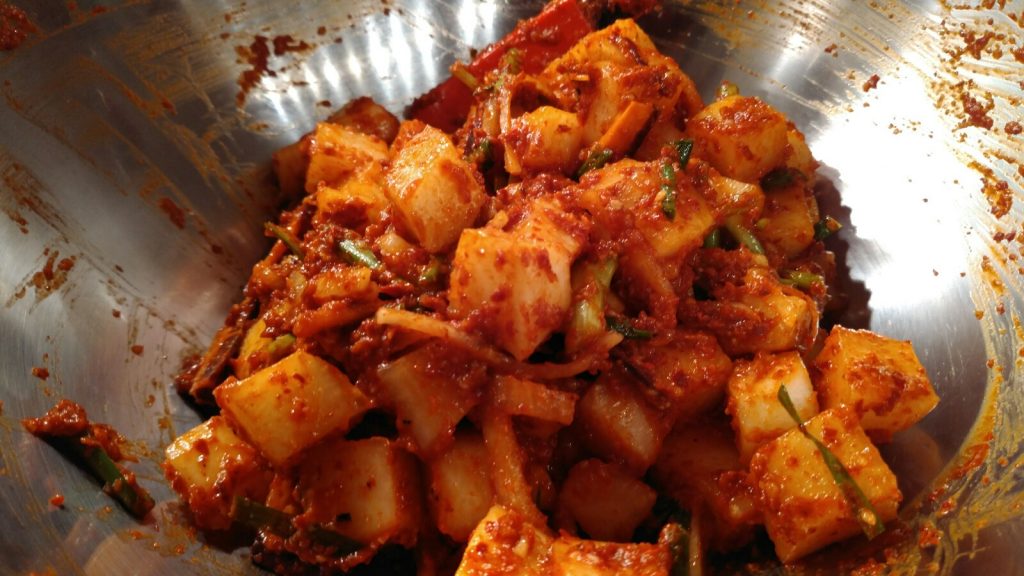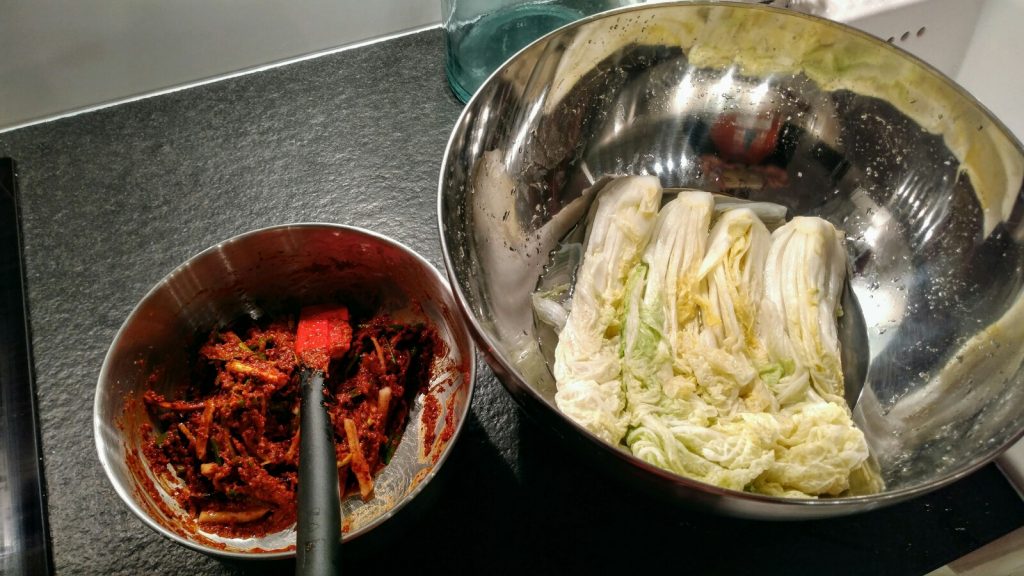After the roasted chicken series I wanted to find out the best kimchi recipe on the web. For the first try I choosed a randomly recipe found on google, and I found Maangchi’s blog. I tried to follow it precisely, here you have her recipe. The small plus to the Maangchi’s recipe is that I also made a radish version with the same kimchi paste.
Test:
1. Preparation:
For this first recipe, I didn’t rushed the process and I spent more than three hours in the kitchen. I was watching videos on youtube to understand better each process. The preparation went very well, there is no difficult part. Need some patience for the salting and for the coating of the cabbage but that’s all. And of course if you choose to ground your own rice flour, it will take some time and energy (probably the next time I’ll just buy some flour). Visually, it really resembled to kimchi, the smell was there (with all that shrimp paste it couldn’t be anywhere else). Here are some photos:
2. 48 hours kimchi: The fermentation has started and we feel the smell in the room. The taste is good, probably to much shrimp paste in the kimchi sauce. The cabbage seems in good shape but the radish is too salty, probably it’s not going to be eatable. I put the containers in the fridge for a slower fermentation process. Next degustation in three days.
3. Five days kimchi: the cabbage kimchi is excellent, well fermented, spicy as in Korea, good smell, perfect sour. Never expected to have such a big success from the first try. Now, the radish kimchi didn’t really fermented enough. The salt is still very present in the taste and comparing to the cabbage I had a strong taste of shrimp paste in my mouth. Probably it needs to ferment some more days or weeks. In the meantime we will enjoy the cabbage kimchi and we’ll come back with comments.
4. 10 days kimchi: still fermenting
- 1 piece napa cabbage
- 1 medium size Daikon radish (around 1kg)
- ½ cup coarse sea salt
- 1 ½ cups water
- 3 tablespoons glutinous rice flour (I grounded in the mortar 4 tbsp of glutinous rice)
- 1 tablespoons brown sugar
- 1 cups Daikon radish matchsticks
- 1 handful carrot matchsticks
- 6 green onions, chopped
- 6 Asian chives, chipped
- 10 fresh and young garlic cloves, minced
- 2 teaspoon ginger, minced
- 1 medium onion, minced
- 3 tbsp vietnamese fish sauce
- 2 tbsp fermented shrimp paste
- 1 cup hot pepper flakes
- 1. Wash and split the cabbage in four parts. To split a cabbage in half without shredding the densely packed leaves inside, first cut a short slit in the base of the cabbage, enough to get a grip on either half, and then gently pull the halves apart so the cabbage splits open. Cut a slit through the core of each half, 2 inches above the stem. You want the cabbage leaves to be loose but still attached to the core.
- 2. Dunk the halves in a large basin of water to get them wet. Sprinkle the salt between the leaves by lifting up every leaf and getting salt in there. Use more salt closer to the stems, where the leaves are thicker.
- 3. Let the cabbages rest for 2 hours. Turn over every 30 minutes, so they get well salted. From time to time you can ladle some of the salty water from the bottom of the basin over top of the cabbages if you want to.
- 4. Wash and cut the radish in 2cm cubes (don't use all the radish, keep some for the kimchi paste that we will cut in matchsticks). Put the radish in a large mixing bowl and pour hot water on it till covered. This helps the radish absorb the kimchi paste better later. Set it aside for about 20 minutes.
- 5. Drain the warm water from the radish after 20 minutes. The radish will be a little warm. Put the radish back into the same large bowl and mix it generously with the coarse sea salt. Set it aside for about 1 hour, mixing once at 30 minutes.
- 1. Combine the water and the rice flour in a small pot. Mix well with a wooden spoon and cook over medium, stirring continuously until it thickens (about 6 minutes). Add the sugar and cook 1 more minute, keep stirring. Remove from the heat and let it cool off completely.
- 1. Cut the carrot and the rest of the daikon in matchsticks.
- 2. Slice the green onions and the asian chives in 2 cm long parts.
- 1. In a blender, bring to a paste the garlic, the ginger and the onion. Add the fish sauce, the shrimp paste, the cooled porridge and the pepper flakes and mix till homogenous.
- 2. Add the the vegetables and mix again till everything is coated.
- 1. One hour after the radish has sat in the salted water, rinse it once in cold water. Don’t rinse it too much, or you will lose too much of the salt. Let aside for the water to drain.
- 2. Use one third of the kimchi paste mixture to enrobe the radish. Mix well until all the cubes are coated with the paste.
- 3. Put in a container and press down. Close the container and let sit at room temperature, in a dark place for 36 hours.
- 1. Two hours after the cabbage has been salted, wash the cabbage quarters a few times under cold running water. Giving them a good washing, to remove the salt. Put them in a strainer over a basin so they can drain well.
- 2. Spread some kimchi paste on each cabbage leaf, going in between the leafs as you did with the salt. When every leaf in a quarter is covered with paste, put it a closed container, press it well and keep at room temperature for 36 hours covered or in a dark place.




